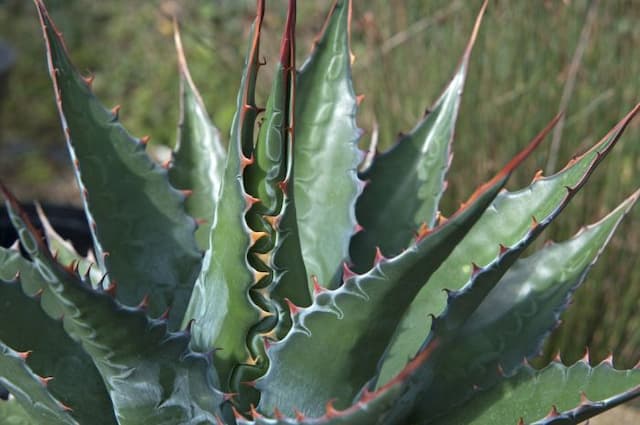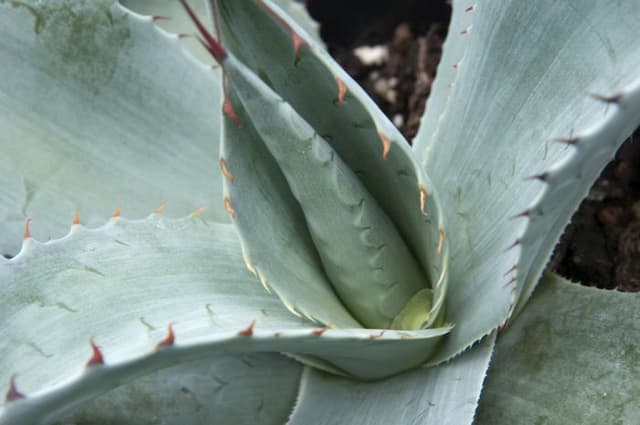Blue Glow Agave Agave 'Blue Glow'

ABOUT
Agave 'Blue Glow' is a stunning succulent boasting a tight rosette of fleshy, blue-green leaves. Each leaf is outlined with a beautifully contrasting red or reddish-orange edge that seems to glow when backlit by the sun. The leaves also feature delicate yellow lines running adjacent to the red edges, adding to its ornamental appeal. The foliage has a smooth texture and terminates in a sharp, pointed tip that demands careful handling. This striking pattern of intense color, along with the smooth finish of the leaves, gives the Blue Glow its distinctive and attractive appearance. The plant has a symmetrical form, with leaves growing uniformly from its central core, creating a neat and compact rosette shape that grabs attention in any garden setting.
About this plant
 Names
NamesFamily
Asparagaceae
Synonyms
Blue Glow Agave, Blue Glow Century Plant
Common names
Agave 'Blue Glow'.
 Toxicity
ToxicityTo humans
The Blue Glow Agave is not known to be toxic to humans if ingested. However, the plant’s sap contains irritating compounds known as calcium oxalate crystals. If the sap comes into contact with skin, it can cause dermatitis or skin irritation in some individuals. The sharp points of the leaves can also pose a physical hazard.
To pets
The Blue Glow Agave is mildly toxic to pets if ingested. It contains saponins and oxalate crystals that can cause vomiting, diarrhea, and drooling. In severe cases, it might lead to more serious symptoms like abdominal pain or swelling of the tissue around the oral cavity. It is advisable to keep pets away from the plant to prevent any potential harm.
 Characteristics
CharacteristicsLife cycle
Perennials
Foliage type
Evergreen
Color of leaves
Blue-green
Flower color
Yellow
Height
2 feet [60 cm]
Spread
2 feet [60 cm]
Plant type
Succulent
Hardiness zones
9
Native area
Mexico
Benefits
 General Benefits
General Benefits- Low Maintenance: The Blue Glow Agave requires minimal care, making it an ideal choice for busy gardeners or those new to plant care.
- Drought Tolerant: It is highly resistant to drought conditions, which makes it suitable for xeriscaping and water-wise gardens.
- Architectural Aesthetics: With its striking blue-green foliage and red-tipped spines, the Blue Glow Agave adds a sculptural element to any landscape design.
- Long-Lived: Agaves are known to be very long-lived plants, offering many years of enjoyment before they bloom once and then die (known as being monocarpic).
- Pest Resistant: It is resistant to most pests and diseases, reducing the need for chemical interventions and making it easier to maintain organically.
- Attracts Pollinators: When it blooms, the tall flower spikes can attract bees, birds, and butterflies, contributing to the health of the local ecosystem.
- Compact Size: Its moderate growth habit makes it well-suited for containers or small garden spaces where it won't outgrow its area.
- Heat Tolerant: The Blue Glow Agave thrives in hot temperatures, perfect for warm climates and full sun exposures.
 Medical Properties
Medical PropertiesThis plant is not used for medical purposes.
 Air-purifying Qualities
Air-purifying QualitiesThis plant is not specifically known for air purifying qualities.
 Other Uses
Other Uses- Landscape Lighting Accent — Agave 'Blue Glow' can reflect landscape lighting beautifully in gardens, providing an attractive, luminescent effect during nighttime.
- Erosion Control — The root system of Agave 'Blue Glow' helps stabilize soil on slopes and prevent erosion.
- Educational Tool — Due to its interesting hybrid nature, Agave 'Blue Glow' can be used in botanical education to explain the process of plant hybridization.
- Artistic Inspiration — Artists and photographers often use Agave 'Blue Glow' as a subject due to its striking form and color.
- Privacy Screen — When planted in rows or clusters, Agave 'Blue Glow' can act as a low-maintenance privacy screen for outdoor spaces.
- Theme Gardens — Agave 'Blue Glow' is a popular choice for creating desert-themed landscapes or succulent gardens.
- Container Gardening — Well-suited for pots, Agave 'Blue Glow' can be used to decorate patios, balconies, and other small spaces.
- Conservation Tool — Being drought-tolerant, Agave 'Blue Glow' is used in water conservation efforts in landscaping in arid regions.
- Bioindicators — These plants can serve as indicators of soil health and appropriate water levels in xeriscaping.
- Culinary Experiments — Although not a common practice, some creative chefs have used Agave 'Blue Glow' as a dramatic, non-edible garnish to enhance food presentation.
Interesting Facts
 Feng Shui
Feng ShuiThe Agave is not used in Feng Shui practice.
 Zodiac Sign Compitability
Zodiac Sign CompitabilityThe Agave is not used in astrology practice.
 Plant Symbolism
Plant Symbolism- Resilience: Agave 'Blue Glow' is a hardy plant that can thrive in arid conditions, so it symbolizes endurance and the ability to withstand hard times.
- Longevity: This plant grows slowly and lives for many years, representing persistence and long-lasting presence.
- Adaptability: The Agave 'Blue Glow' has adapted to survive in tough environments, making it a symbol of flexibility and adaptability in life.
- Self-Sufficiency: As a plant that requires minimal care, it represents independence and the ability to take care of oneself.
- Protection: The sharp edges of the leaves can deter animals, symbolizing safeguarding and defense against threats.
 Water
WaterThe Blue Agave should be watered sparingly, as it is drought-tolerant and prefers dry conditions. During the growing season in spring and summer, water it once every two weeks with about a quarter to half a gallon of water, ensuring the soil is completely dry between watering sessions. In the fall and winter, reduce watering to once a month or less, depending on the humidity and temperature. It's crucial to avoid overwatering, as this can lead to root rot, especially in cooler temperatures.
 Light
LightThe Blue Agave thrives best in full sunlight, where it can receive direct exposure for at least six to eight hours each day. The ideal location would be a south-facing window indoors or an unobstructed area outdoors where it can bask in the sun's rays. It tolerates partial shade but its growth might be slower, and its colors less vibrant.
 Temperature
TemperatureBlue Agave does well in temperatures ranging from 50 to 85 degrees Fahrenheit. It can tolerate short periods of colder weather down to 30 degrees, but should not be exposed to frost. To ensure healthy growth, keep it in an environment where night temperatures don't drop below 50 degrees. The ideal temperature range for this plant during the day is between 70 and 80 degrees Fahrenheit.
 Pruning
PruningPruning for Blue Agave is generally done to remove any damaged or dead leaves and to maintain its appearance. It is best to prune in the spring or early summer when the plant is actively growing. Pruning is not required often; it can be done every few years or as needed when leaves become damaged.
 Cleaning
CleaningAs needed
 Soil
SoilThe best soil mix for Blue Glow Agave is a well-draining cactus or succulent mix, amended with coarse sand or perlite to increase drainage. The pH should be slightly acidic to slightly alkaline, ranging from 6.0 to 7.5.
 Repotting
RepottingBlue Glow Agave is a slow-growing plant that does not require frequent repotting; it can be repotted every 2-3 years or when it outgrows its current container.
 Humidity & Misting
Humidity & MistingBlue Glow Agave prefers dry conditions and thrives in low humidity environments typical of arid and desert-like regions.
 Suitable locations
Suitable locationsIndoor
Place in a sunny spot, well-draining soil.
Outdoor
Full sun, well-draining spot, protect from frost.
Hardiness zone
9-11 USDA
 Life cycle
Life cycleThe life cycle of the Blue Glow Agave starts with germination, where it grows from a seed, though commercial propagation often uses offsets or tissue culture. It then enters a long juvenile phase, during which it develops its distinctive blue-green leaves with red and yellow margins, growing slowly and storing energy in the form of carbohydrates in its core. This rosette stage can last for several years as the plant matures and becomes more pronounced in form. The Blue Glow Agave is monocarpic, meaning it will flower only once in its lifetime; after reaching maturity (typically between 10 to 15 years), it sends up a tall flower stalk, which can be several feet high, bearing clusters of yellowish flowers. After flowering, the plant will gradually die, but it often produces “pups” or offsets around its base, which can be replanted to start new plants. The parent plant's lifecycle ends with its death following the seeding phase, which completes the cycle as the seeds or pups carry the genetic legacy to the next generation.
 Propogation
PropogationPropogation time
Spring-Early Summer
The most popular method of propagating the Agave 'Blue Glow' is by separating and transplanting the offsets, commonly referred to as "pups," that are produced around the base of the parent plant. These pups are essentially small clones of the mother plant, and once they've reached a substantial size, you can gently remove them with a clean, sharp knife. Ideally, this is done in the late spring or early summer, when the plant is actively growing. Allow the pups to dry and callus over for a few days before planting them. When ready, you can plant these pups in a mixture of potting soil and sand or a well-draining cactus mix. Make sure to water them modestly until they establish themselves and show signs of growth.









